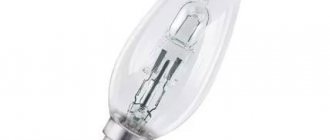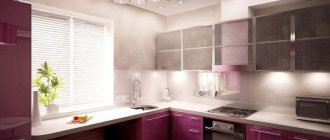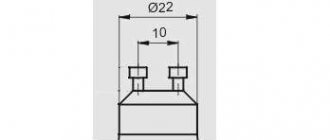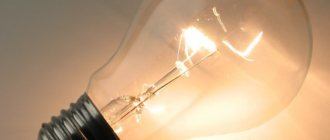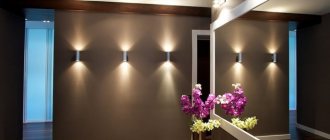The prototype of the first electric light bulb was developed by engineer A. N. Lodygin in 1874. Five years later, American inventor Thomas Alva Edison modernized the device so that it could be produced on an industrial scale. Both discoveries changed the life of not only the scientists’ compatriots, but also the whole world. Today you can find LED, energy-saving, and other light sources on the market, but the traditional incandescent lamp remains competitive and in demand. In the article we will talk in detail about this invention, and also give recommendations on how to choose a reliable model.
Working principle of an incandescent light bulb
For more than a hundred years, the design of the device has remained virtually unchanged, only the materials for its manufacture have been improved. We will briefly describe how it works in order to further acquaint you with its characteristics. Below we have placed a drawing showing the structure of an incandescent lamp. The material is taken from the physics textbook by Peryshkin A.V.
The main element on which the operation of the lamp depends is the filament. It is attached to the electrodes and an electric current passes through it. The tension causes the thread to heat up and glow.
To produce warm yellow light that is comfortable for your home, the temperature inside the bulb must reach at least 2500 degrees. Therefore, tungsten is used as the metal from which the filament body is made. To increase the effective radiation area, the tungsten wire is twisted into a spiral or several metal ribbons are used.
The filament body is protected from environmental influences by a flask made of soda-lime silicate glass. We are accustomed to the fact that it has a traditional pear-shaped shape, but the model range is represented by unusual candle-shaped, mushroom-shaped or spherical products.
The principle of operation that is studied at school
The school curriculum for 9th grade physics examines the effect of heating a conductor in the process of increasing resistance with increasing current - the transformation of electrical energy passing through a tungsten filament to the emission of radiation in a wide spectral range, including heat and light. Visible light is a very modest amount in this spectrum.
To prevent the oxidation and destruction of tungsten, it is necessary to create a vacuum in the glass bulb of the lamp, for which air is pumped out of it - the medium for oxidative processes.
Practice has shown that filling the flask with any inert gas increases the glow strength. Therefore, most LONs are now produced as gas-filled, leaving the use of vacuum only in the technology of low-power lamps (25W).
One of the latest innovations in lighting is LED lamps. They successfully replace the traditional incandescent lamps, but have not yet become widespread due to their high cost.
How to choose an incandescent light bulb: overview of technical parameters
To use a lamp in everyday life, you need to know its main characteristics. The manufacturer is required to indicate them on the packaging.
- Power
(W, W) - the amount of electricity consumed. For a household lamp, 40-60 W is enough. This is the size that lighting fixtures are designed for. If the parameter is less, the room will remain dark; if it is more, the lamp will deteriorate.
- Lumen
(Lm) - light brightness. The value itself does not provide the consumer with any significant information, but the indicator is used to compare the efficiency of an incandescent light bulb with other light sources.
- Volts
(V, V) is the mains voltage from which the product operates. As a rule, the value is 220. If the range is indicated from ... to ..., then the device is resistant to voltage surges.
- Watch
(h) is the working time of the light bulb.
- Base size
. We will talk about this parameter below.
2.3. Special incandescent lamps made in Germany
2.3.1. SPECIAL OVEN oven lamps, teardrop and pear-shaped
Rice. 6. SPECIAL OVEN lamps for ovens
| Type | Drawing | Power, W | Base | Luminous flux, lm | Length l, mm | Diameter, mm |
| TR IM 300 GD 40 | 1 | 40 | E14 | 400 | 80 | 45 |
| BFM KL 300 GD 15 | 2 | 15 | E14 | 85 | 50 | 22 |
2.3.2. Pear-shaped lamps, matte and transparent
Rice. 7. Pear-shaped lamps, matte and transparent
| Type | Drawing | Power, W | Base | Luminous flux, lm | Length l, mm | Diameter, mm |
| BFM IM 15 | 1 | 15 | E14 | 110 | 57 | 26 |
| BFM IM 25 | 1 | 25 | E14 | 190 | 57 | 26 |
| BFM KL 15 | 2 | 15 | E14 | 110 | 57 | 26 |
| BFM KL 25 | 2 | 25 | E14 | 190 | 57 | 26 |
2.3.3. Lamps for lighting rooms when watching TV programs SPECIAL TV
| Type | Drawing | Power, W | Base | Length l, mm | Diameter, mm |
| BFM BLAUGLAS 25 | 7 — 3 | 25 | E14 | 74 | 32 |
2.3.4. Cylindrical lamps, transparent and frosted
Rice. 7. Cylindrical lamps
| Type | Drawing | Voltage, V | Power, W | Base | Luminous flux, lm | Length l, mm | Diameter, mm |
| ROE 2 KL 25 | 1 | 220 | 25 | E14 | 165 | 115 | 20 |
| ROE 3 IM 25 | 2 | 220 | 25 | E14 | 195 | 100 | 30 |
| ROE 3 IM 40 | 2 | 220 | 40 | E14 | 380 | 100 | 30 |
| ROE 6 IM 40 | 3 | 220 | 40 | E14 | 380 | 73 | 30 |
| ROE 1 KL 15 24V | 4 | 24 | 15 | E14 | 150 | 85 | 20 |
| ROE 1 KL 15 40-42V | 4 | 42 | 15 | E14 | 130 | 85 | 20 |
Types of incandescent light bulbs
Safety standards and product labeling are determined by GOST R 52712-2007. We will not study in detail the technical standards of all types of devices, but we will provide a classification in accordance with consumer needs.
By type of cylinder filling
Flasks are vacuum
and gas-filled. In the first case, air is pumped out of the cylinder so that tungsten does not oxidize. But in a vacuum it begins to evaporate, the wire becomes thin and breaks. Evaporation also causes the glass to become cloudy and the light to dim. Such lamps are manufactured with a power of up to 40 W and can only be a source of additional lighting.
In gas-filled
In samples, gas particles prevent tungsten molecules from leaving the filament. According to experimental data, the light bulb should remain intact for up to 1000 hours. But manufacturers make an error based on environmental conditions, and this figure may increase or decrease by 50%.
Sometimes iodine or bromine is added to the flask. After evaporation, tungsten atoms return to the filament body. This internal composition of the cylinder increases the performance of the product up to 2000-3000 hours and increases the temperature of the coil, thereby increasing the lighting capacity.
By area of application
Requirements for light bulbs in a particular area are regulated by the relevant GOSTs, so we will not duplicate the content of regulatory documents, but will only list the areas of use of the devices:
- General purpose - for street lighting of buildings and open spaces.
- Local lighting - for residential and work areas.
- Transport - for cars, ships, aircraft and railway transport.
- Miniature and subminiature - for signaling devices, control panels, portable lights.
- Specialized - for use in a narrow field. For example, film projection, lighthouse, etc.
According to the shape of the base
The size and characteristics of the thread determine whether the light bulb will fit into the socket or not. To prevent the buyer from making a mistake, manufacturers have developed a uniform marking for the base. It consists of three conventional symbols.
First capital letter
indicates the type of base:
- E - Edison;
- G - pin;
- R - with recessed contacts;
- B - pin (bayonet);
- S - soffit;
- P - focusing;
- T - telephone;
- K - cable;
- W - baseless lamps.
Numbers
— thread diameter in mm.
Uppercase or capital letters
- number of contact plates, pins or flexible connections:
- s - one.
- d - two.
- t - three.
- q - four.
- p - five.
The most common types of E14
(minion) and
E27
.
By glass coating
The flask can be transparent or with a special coating. It is important to understand that when painting a cylinder, the lighting capacity of the device decreases: with a matte coating - by 3%, with a white coating - by 20%.
Luminous flux measurement
There is a luminous flux meter called a lux meter. The usefulness of a device for measuring luminous flux is invaluable in cases where there are specified lighting parameters in a room. For example, the illumination of a children's room should be 200 lux (lux), and for bedrooms, living rooms and kitchens an illumination of 150 lux is considered comfortable.
You can rely on the characteristics indicated on the packaging of light bulbs, allowing for a large margin of error. Chinese manufacturers are especially guilty of indicating inaccurate light output data, as they tend to overestimate the characteristics of their products.
Most smartphones are equipped with built-in sensors that automatically change the brightness of the screen depending on the light level. It is enough to install the Luxmeter program on your smartphone to be able to measure the illumination in the room.
Luminous flux unit
Luminous flux power is measured in lumens (lm). 1 lm is equal to the flux of light emitted within a solid angle by a point source with an intensity of 1 cd. (candela).
Defining formulas
The variety of quantities characterizing light sources cannot be understood without understanding the essence of how some physical characteristics transform into others, and what dependencies exist between them. To do this, use several defining formulas:
- Light flow:
- The power of light:
- General illumination:
- Illumination at a specific point on the surface that is not perpendicular to the light source:
- Horizontal surface illumination:
- Vertical surface illumination:
- Luminosity (to determine the amount of light emitted by chandelier shades):
It is a rare consumer who will thoroughly delve into these formulas, calculating the values, before buying a light bulb.
Color temperature of luminous flux
The comfort of being in a room is determined not only by its level of illumination, but also by the shade of light that the light sources emit. This characteristic of light bulbs is called color temperature.
The human eye is more adapted to perceive long-wavelength light, which contains red and orange colors. It perceives short-wave radiation, located in the blue and violet regions of the spectrum, much worse. Light with a bluish tint is perceived by the eye as harsh and annoying. Causes rapid fatigue.
Taking these features into account, manufacturers label all light sources with consumer-friendly names:
- warm;
- day;
- cold.
Essentially, we are talking about a commercial designation for the temperature of the color flow. The lower the color temperature, the more “warm”, visually pleasing light the light bulb emits.
A person’s perception of the same interior (landscape) at different color temperatures is clearly presented in the figure:
PICTURE 1
Differences in image perception depending on color temperature
Recommendations for choosing a light bulb
When purchasing light bulbs, they are guided primarily by the size of the base and power. These two parameters are easy to determine from an old, burnt-out light source.
Especially for lovers of traditional light bulbs, filament devices on LEDs are produced, similar in shape, but distinguished by their characteristics.
If you choose a device with a lower power, the luminous flux will be weaker; if you choose a higher power, you risk the integrity of the lampshades - they may become deformed due to the high heating temperature.
In addition to the technical characteristics, it is worth paying attention to the quality of the lamp. Preference should be given to products with a wide base contact, a soldered current conductor, and a stably fixed filament.
Peculiarities
Incandescent light bulbs are produced in a power range from 25 W to 150 W, they can use mains voltages of 220 and 380 V. The standard operating period of a typical 60 W lamp is 1000 hours. The spectral shade of its light is yellow.
In addition to production technology and power, electric lamps are classified by the type of their base, or the metal base of the device. By the way, the letter “E” means the classic standard size of the base; it got its name in honor of the inventor of the classic light bulb, Edison. The number 27 indicates the diameter of the base - this is a classic option for lamps since the times of the USSR, often used to this day. These types of lamps are the most popular, they are used almost everywhere, and most modern electrical lighting devices on the Russian market are designed specifically for such 60 W lamps.
“Lamp Classic” is distinguished by the most favorable price for the buyer, a simple device and a reliable design. This device is familiar to the vast majority of people.
But the E27 60 W incandescent lamp is still not without its own disadvantages. For example, this lamp is often inferior in durability to its more modern competitors. The fact is that the incandescent element, made of tungsten, inevitably wears out and may fail. In addition, during operation, the lamp bulb tends to darken due to the accumulation of a special gas inside. This negatively affects the brightness of the light.
